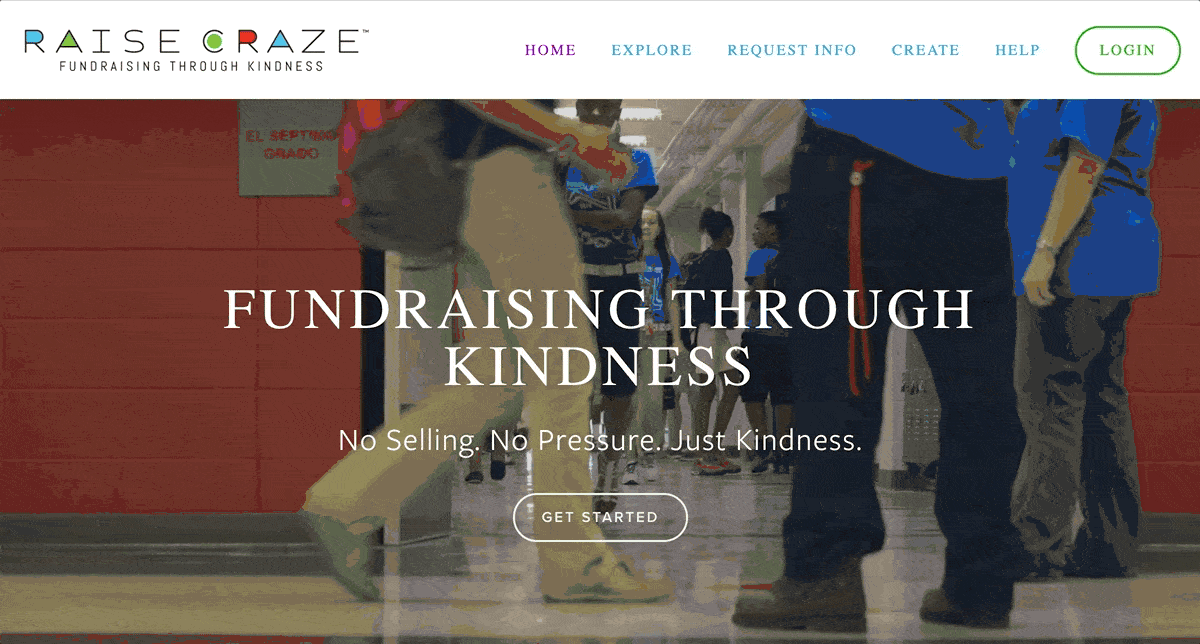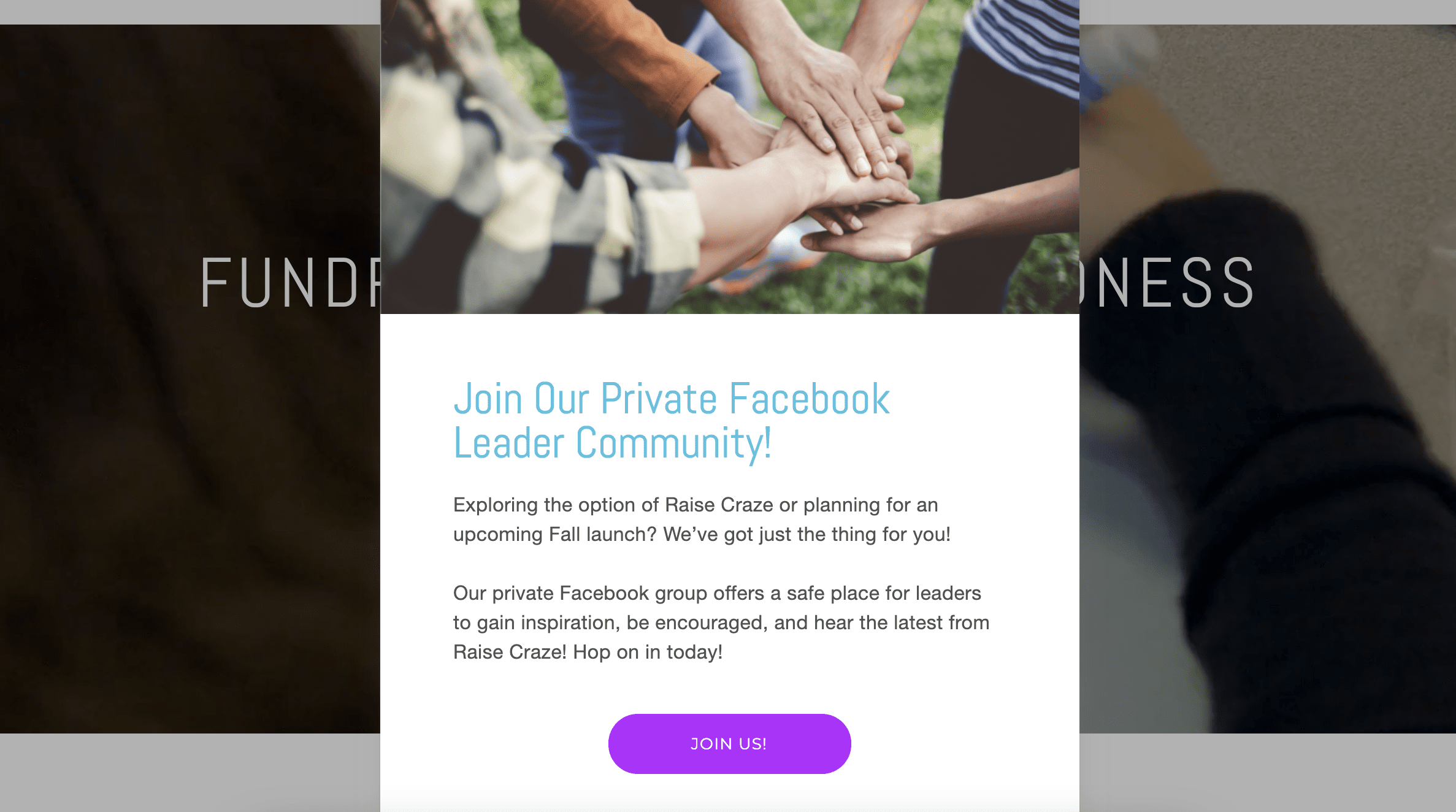“We just don’t have the time or the resources to do X, Y, and Z!”
Sounds familiar?
Yep, this is a line commonly heard in many businesses, especially small businesses where the number of marketing team members can generally be counted on one hand—or even just one finger.
For small or one-person marketing teams, it’s never been more challenging to juggle SEO, PPC, leads, sales, sign-ups, community building, social media, website management, and on and on…

In need of some expert advice to get you through your daily tasks? We reached out to a one-person marketing machine, Raise Craze’s Claire Seymour, to find out just how she gets it all done.
Raise Craze: Small but Mighty
Remember those painful school fundraisers where you had to sell soap or gift wrap to pay for renovations or a new chess club? Well, Raise Craze facilitates those in a digital, cashless environment—minus the painful sales tactics.
Instead of having to knock on doors to sell products—or just having parents pick up the bill—with Raise Craze, kids volunteer acts of kindness in their communities in exchange for donations.

It goes back to starting with how we can teach kids the value of gratitude and how small acts of kindness can make a huge impact in the world, even if it’s just their immediate world. And collectively when you do something little to brighten someone’s day, there is going to be a ripple effect. — Claire Seymour, Marketing Director, Raise Craze
Raise Craze offers curated programs for different age groups. For example, young ones can pay it forward with smaller acts like putting out birdseed, while older kids and teenagers can take on bigger tasks like volunteering at community centers.
Heartwarming, right? Well, get ready for your heart to just burst.
Founded by two parents fed up with fundraising companies taking up to 70% of their kids’ hard-earned money (nuts, right?), Raise Craze takes no more than 10% in fees. And while they operate with many one-time fundraising clients, their bread and butter come from recurring clients they build relationships with over the years. Currently, their roster boasts more than 200 schools scattered across 48 states in the U.S.
Raise Craze’s staff consists of just four employees, with Claire the sole person in charge of marketing for the past six years. Yup, you could say she’s been around the block making big things happen with limited resources.
Wanna know how an expert like Claire gets it done?
1. Know What Sets You Apart
Raise Craze swim against their industry current. They take fewer profits than competitors while creating an experience based on giving—both as a donor and receiver. They’re completely different from their competitors, and it’s something they amplify as loud as they can. “It’s normally the reason why our customers land on us—because they’re looking for something different and, frankly, something meaningful,” Claire says.

Our company was created to provide an alternative to the traditional school fundraiser. We help organizations achieve their financial goals while bringing a meaningful experience to students, families, and the entire community. The focus on kindness and giving back has really set us apart from other fundraisers.
To Raise Craze, this is more than a mission: It’s a unique selling point, which is why it’s put front and center in everything they do. Have a look at Raise Craze’s homepage to see how that works in practice:

If someone lands on the website and doesn’t scroll an inch lower, they’ll walk away knowing exactly what Raise Craze is about. “The focus on kindness and giving back has really set us apart from other fundraisers,” Claire explains.
It’s estimated that people only read about 28% of content when visiting a website, so hitting it out of the park from the get-go is super important. In this example, Raise Craze offers a textbook example of maximizing the impact of a first impression. It’s clear, concise, and most importantly, shows what working with Raise Craze looks like—and doesn’t it look like fun?
2. Let Social Proof Do the Talking
Social proof is regularly listed in “best practice” blogs—and for good reason.
Because. It. Works. We know it. Claire knows it. And you should know it too.

In our industry (and I’m sure others as well!), the customer doesn’t want to feel alone, so being able to support them with testimonials is a great way to provide a sense of community. We all want to feel connected!
Yes, this means prioritizing testimonials on web pages and landing pages, but Raise Craze has also taken the “social” aspect of social proof to the next level.
Raise Craze’s primary target customers are schools. But the target audience is organizations (consisting of parents and teachers) who run fundraisers on behalf of schools. Where do the people behind these organizations hang out? Social media. Or, more precisely, Facebook.
“Word of mouth is such a big way that we get business, so Facebook and digital communities are extremely important for us,” Claire explains. This means going above and beyond simply being on the platform, and running a dedicated Facebook group where organizers can connect and share fundraising experiences.

And it’s a win-win scenario. Clients can connect and engage with each other while creating social proof for Raise Craze. “People just have these incredible stories that they want to share about how their fundraiser has affected their community and students. It helps our work as a small team, with our work being amplified in that way,” says Claire.
Talk about letting your social proof do the talking for you, right? It’s no surprise that Claire’s biggest piece of advice to other small marketing teams is to connect with audiences to get that social proof working for you:

Utilize the power of social and user-generated content. Encourage that community because that strengthens your impact as a small team if you can use the power of other people’s words. And don’t take that for granted—celebrate that and celebrate those people.
The lesson here is simple: Find out where your audiences are talking and insert yourself into the discussion. “I believe that knowing your audience and staying true to your brand’s mission are pivotal when achieving marketing success,” Claire adds.
3. Lean on Landing Pages
Whether we like it or not, competitive modern marketing is pay-to-play—PPC, Google Ads, and social media campaigns. But pouring money into paid advertising without a clear funnel or user journey is a quick way to lose all your budget without having anything to show for it.
Even within Raise Craze, a company that gets a large chunk of their customers through word-of-mouth referrals, paid campaigns and landing pages aren’t sidelined. “Search has been pretty huge for our growth,” Claire explains.
Success in this area isn’t too surprising as their top keywords are incredibly niche, with a high search intent behind them. (When someone searches “school fundraising,” they’re lookin’ for something pretty specific, right?) The trick is using that traffic in a meaningful way—and that’s where landing pages enter Raise Craze’s funnel.

For us, the value of landing pages is to tell a story in a really beautiful and concise way. It’s a visual display of your elevator pitch. It draws your target customer in, and if you’re doing it well, they usually want to know more—funneling them further down the sales channel!
Have a look at one of their landing pages:
When it comes to Raise Craze’s landing page strategy, Claire keeps things straightforward. “Our landing pages are used primarily for lead generation, so we make sure that our forms are as simple as possible. Less is more! The user is way more likely to fill out [a form] if it’s quick and easy answers,” she explains.
The true mastery is tailoring each campaign—and every landing page variant within that campaign—to seasonal nuances and current talking points. “It’s important to pick up on trends related to your industry. Being in-tune to the cyclical changes is a must!”
From there, it’s all about monitoring audience behaviors and tweaking copy to match those insights.
Pssssst … Looking for tips on creating high-converting copy? Find out how to make every word count with the Unbounce guide to copywriting.
4. Power Up with the Right Optimization Tools
Optimization is often where small teams struggle. Just getting campaigns up and running is an achievement, yes? That’s one of the main reasons why Claire and Raise Craze consciously partners up with tools to make the job much easier.
One of these tools is Smart Traffic, an Unbounce feature that sends visitors to the page variant where they’re most likely to convert.

I’m far from an expert in optimizing conversion rates, but I know there’s no landing page that will resonate with all customers. We rely on Smart Traffic to know which landing page to serve up based on that particular customer.
And it *works*. Just look at that conversion rate lift:

A key tactic for Claire when putting together landing page campaigns is segmenting campaigns based on broad audiences, and then—within each campaign—tailor variants with different messaging and focuses. “Testing multiple variants is so important when trying to figure out what is going to resonate with your target audience,” she says.
Variants? What even are those? Think of variants as different landing page options for your campaign. Maybe it’s copy variations, a tweak in design, or a page with much more (or less) information. The possibilities really are endless. Learn more about how to create variants with Smart Traffic for winning results.
What makes Smart Traffic a great tool—especially for small businesses struggling with resources—is that it uses artificial intelligence to learn about your audience’s preferences. So instead of waiting on multiple A/B tests to see if a green or red header works better, you can use both—and Smart Traffic will send visitors to the version where they’re most likely to convert. TA-DA! Just like that. “It’s a massive resource when a system can notice trends and help you build things that will perform better and help you make better decisions,” Claire explains.
When it comes to bringing AI into the Raise Craze marketing stack, Claire is cautiously optimistic. “I see it being a tool and partner in marketing efficiency. Hopefully, it will allow marketers to speed up their more tedious processes.” (Spoiler alert: It already does. The new Unbounce Smart Builder takes half the time to get landing pages up and running. How’s that for speeding up tedious processes?)
No Marketing Team Is Too Small to Succeed
Ultimately, whether you’re a one-person marketing team or managing a group of 50—there’s always going to be stuff you don’t find the time to do.
Don’t fall into the trap of obsessing about all the things you could be doing. Rather, focus on how you can make the most of what you currently have. Look at your channels, look at your audience, and—above all—look at your tools. Marketing is already hard enough, so follow the Marie Kondo method to straighten things out. If it doesn’t spark joy—or, ahem, make your life easier—cut it out or find an alternative solution.
If the small but mighty team at Raise Craze can do it, so can you. You got this. 💙


![[Unbounce – BOFU] Pricing – V3 – 2024 Unbounce Conversion Rate Optimization CTA banner](https://unbounce.com/photos/Unbounce-BOFU-Pricing-V3-2024.jpg)
